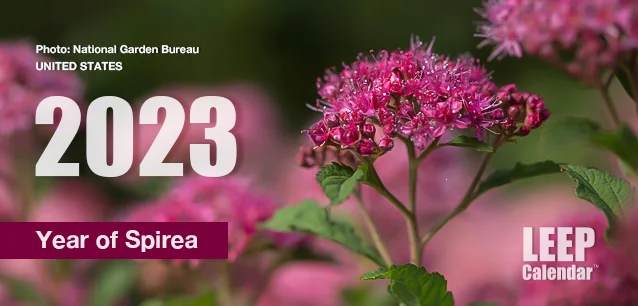 AD
AD
Today is: November 18
Scroll to explore events active on this date.
Additional Events on LEEP
LEEP INK FEATURES

August? Absolutely!
In August, we live through the Dog Days of Summer. It's hot and often humid, and those who can leave for better climates do. Down south, winter is in full force. August is also known as "the ...

In The Heat of July: July 2025 Events
Is it hot enough (or cold enough if you're below the equator) for you yet? There is actually a day for that! Like every month, I pick a diverse collection of events you may or may not know about. This ...

May Blooms: Events in May 2025
Along with October, May is one of the most densely packed months of the year. It's before the summer humidity and the last whole month of the school year. The weather is warming in t...
About 2023, Year of Spirea
Retail , United States
Ends: Dec 31, 2023
DESCRIPTION:
2023 is the Year of Spirea.
Spirea, a genus comprising nearly 100 species of deciduous or semi-evergreen shrubs, has a history that spans continents and cultures. Native to the temperate regions of the Northern Hemisphere, especially East Asia, Spirea's journey from wild landscapes to cultivated gardens is marked by aesthetic appeal and horticultural discovery.
The beauty of Spirea lies in its delicate clusters of tiny flowers, often white or shades of pink, that bloom in spring or summer, depending on the species. This appealing characteristic caught the eye of gardeners and botanists alike, making Spirea a sought-after plant for ornamental purposes.
In its native regions, particularly Japan and China, Spirea has been cultivated for centuries, with some species having special cultural significance. Its graceful appearance has made it popular in traditional gardens, often planted alongside other classic Asian flora.
Spirea's introduction to the Western world began in the 18th century when plant explorers and botanists started to travel to East Asia. These expeditions resulted in discovering and exporting various Spirea species to Europe and North America, where they quickly became popular among garden enthusiasts.
The versatility of Spirea contributed to its widespread acceptance in different gardening traditions. It's prized not only for its beautiful flowers but also for its attractive foliage that adds interest throughout the growing season.
The various species of Spirea offer different sizes and growth habits, making it suitable for multiple garden designs.
Breeding and hybridization efforts in the 19th and 20th centuries developed new cultivars, enhancing Spirea's attributes such as flower color, shape, and blooming time. These horticultural innovations have further solidified Spirea's place in modern gardens.
Today, Spirea continues to be a favorite among gardeners and landscapers for its easy care and aesthetic charm. Its historical journey from the wild terrains of Asia to gardens worldwide reflects a convergence of botanical exploration, cultural appreciation, and horticultural innovation.
VIDEOS
Currently, this event does not have supporting videos.
SUPPORTING DOCUMENTS
Currently, this event does not have supporting documents.
ADDITIONAL IMAGES
Currently, this event does not have supporting images.
Where would you like to go now?
 AD
AD


/footer-logo.svg)
